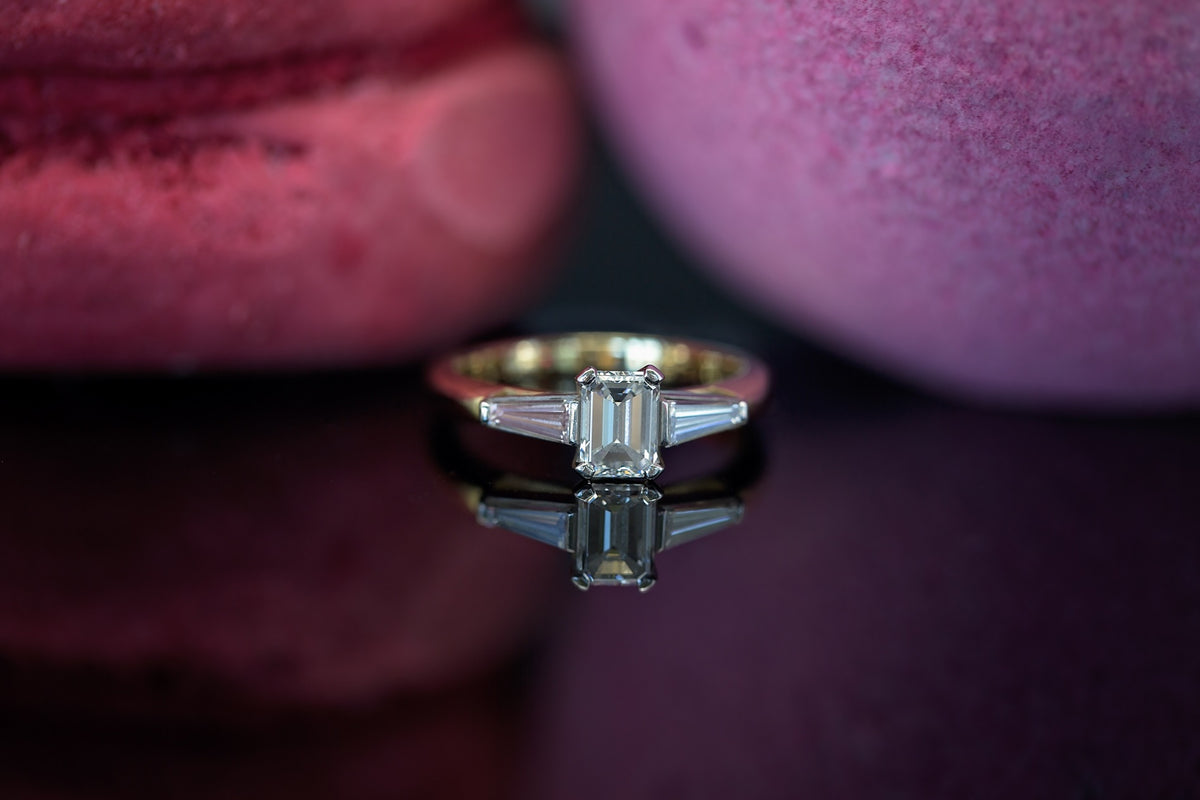If you’re purchasing a diamond piece for yourself or a beloved someone, you’re likely looking forward to some joyful experiences—perhaps the sparkle in their eye when they say I do, or finally finding the perfect piece to accompany your style. But along the way, one puzzling decision you may face is the choice between a baguette vs emerald cut diamond ring.
Rectangular cuts like these have been a popular style for decades, with the emerald and baguette cuts in the lead since the 1920s.1 The unique, elongated shape of each gives the jewelry a boldness that’s sure to stand out. But their similarities can also make it difficult when it comes time to decide.
To give you confidence in whichever diamond cut you choose, we’ve compared the emerald cut vs baguette cut diamond below.
Characteristics of Emerald vs Baguette Cut Diamonds
To answer the question "are baguettes real diamonds?"- yes, and contrary to their respective titles, the baguette cut diamond is not the doppelganger of your favorite French bread, nor are all emerald cuts green. Although you can identify both of these diamond cuts by their rectangular shape, there are key features that set them apart.
Though they may seem minuscule, the subtlest of differences in the cut of a stone can alter the presentation and feel of a fine jewelry piece. Let’s take a look at some physical characteristics to help you determine which of these classic cuts is best suited for you or your loved one.
Defining Features of an Emerald Cut Diamond
This cut has plenty of features to make it unique. You can pick out an emerald cut diamond by looking for the following characteristics:2
- Step cut – A step cut diamond features facets that are parallel to one another and is flat on the surface. This cut style might appear less sparkly, but can offer a modern, sophisticated look.
- Numerous facets – Facets are “geometrically arranged, flat surfaces”3 that gem cutters cut into gems in order to shape the stone for use in jewelry, create mesmerizing patterns, and help each gem shine. An emerald cut diamond can have over 49 facets, meaning it may offer a more brilliant appearance than the baguette cut.2
- Flat corners – Also known as beveled corners, the flat corners of an emerald cut diamond slightly soften the sharpness of its rectangular shape.
- Large table – A diamond’s table is the upper top facet of the stone, typically the largest and arguably the most important feature in determining brilliance and light.3 The emerald cut diamond features a large table, allowing it to reflect plenty of shine.
Key Elements of a Baguette Cut Diamond
A baguette cut may have some similarities to an emerald cut diamond, but it also stands out for several reasons. You can see the following in the baguette diamond cut:
- Step cut – Much like the emerald cut diamond, a baguette diamond also features a step cut style—meaning it lends a similar level of elegant, minimalistic flair.
- Fewer facets – Unlike the emerald cut diamond, however, a baguette diamond usually only features around 14 facets. While this can add to the sleekness of the style, it may lead to less brilliance than the emerald cut.
- Sharp, 90-degree corners – In contrast to the emerald cut diamond, the corners of a baguette cut are sharp—creating crisp, clean lines all the way around.
- Large table – Similar to the emerald cut, the baguette diamond cut also tends to feature a large table. Though it may come with less brilliance, this diamond cut still has the capacity to reflect a good deal of light.
Now that you have a solid overview of these two cuts’ unique features, let’s learn about their individual histories and go into a bit more depth about what they have to offer.
All About the Elegant Emerald Cut Diamond
The emerald cut holds a lot of history, with origins dating back to the 16th century.4 This cut received its name due to its initial use as a cut for emerald gemstones. With time, jewelers began cutting diamonds in this shape as well, as the cut reduced the pressure, and thus imperfections, in the diamonds during the cutting and shaping process.
This stunning cut is famous for the following reasons:
- Hall of Mirrors effect – The many facets of this cut create a mesmerizing “hall of mirrors” effect. The step cuts cause a dramatic pattern of light and dark within the diamond. You will easily see the intricacy of these cuts through the emerald cut’s generously sized table.
- Art Deco era – During the 1920s this cut’s popularity skyrocketed due to the Art Deco period. In this era, jewelers and consumers alike exalted geometric shapes, clean lines, and sleek symmetry. Now, fine jewelry that shows off this cut instantly gives off a nostalgic and vintage feel.
Popularity and Price
When it comes to the popularity race of the baguette vs emerald cut, the emerald diamond cut wins by a landslide. Because of their brilliance and elegant appeal, they are a classic cut in earrings and rings alike, particularly common for an engagement ring, an eternity ring, and even a wedding ring. Pass any luxury jewelry store window, and you’ll start to notice the sheer number of emerald cuts displayed.
This cut has made it onto the hands of various celebrities and even the British Royal Family. Camilla, Duchess of Cornwall, as well as actress Angelina Jolie both had enchanting engagement rings with an emerald cut diamond as the center stone.5 Jewelers followed tradition and supported Camilla’s ring with baguette diamonds on either side in an Art Deco design.
Emerald cut diamonds are traditionally more expensive than the baguette cut, but more affordable than many round cut diamonds currently on the market.
All About the Unique Baguette Cut Diamond
We can trace the recent history of this cut back to the beginning of the 1900s, when Cartier reintroduced it for diamonds in 1912.1 The name originates from the French word bague, meaning “ring” or, formally, just “jewel.” Thus, a baguette would be a “small jewel.” But some prefer to keep it simple and say the cut was named for its shared resemblance with the long, slim loaf of French bread.
Here are some intriguing aspects of the baguette diamond cut:
- Staircase facets – Its facets take the appearance of smooth steps that gradually narrow from the edges to the center of the gem.
- Art Deco era – This cut, just like the emerald, gained popularity in the Art Nouveau and Art Deco movements of the 1920s due to its geometric diamond shape.
- Slimming effect – Baguette cut diamonds are most often cut in a dramatically elongated 5:1 ratio, creating a slimming effect when you place it on your finger. However, they are also available in a near-square shape and as a tapered version with long sides that angle inwards.
Popularity and Price
The baguette diamond ring is admittedly not as common as its glamorous cousin, but that doesn’t mean you have to write it off. Other than side stones or diamond accents in rings, more recently we have seen them in earrings, with jewelers arranging several of them in delicate hoops or even as stand-alone studs.
There is another reason why baguette cut stones haven’t caught up with emerald cuts in terms of ring center stone popularity: When jewelers cut them in large sizes, their shape makes them more prone to them catching onto something and chipping.
That said, diamonds in the baguette cut are often more affordable than those in the emerald cut due to their fewer facets, simplifying the cutting process.
Things to Keep in Mind When Purchasing
Once you have decided on the cut for your next fine jewelry piece, it’s time to start looking at individual stones. Aside from the features we’ve already mentioned, other aspects—like imperfections and proportions—should also influence your decision A question you may be asking yourself is if you want a natural or lab grown diamond ring. Additionally, it’s also worth considering the company you’re purchasing from.
Consider the following three aspects when purchasing either one of these cuts:
- Inclusions – As both of these cuts have large tables, any inclusions or imperfections may be more visible than diamonds in other cuts. To make sure these marks aren’t going to distract from the beauty of the piece, invest in diamonds that have VS clarity or above.
- Proportions – Take into consideration the proportions of the stone that you choose. An already attractive diamond doubles in drama when there is harmony between its width and length, giving your stone a balanced and elegant look and feel.
- Ethics – Pay close attention to where your diamonds are coming from—including whether the company has grown them in a lab or if they are mined in an ethical, conflict free way. If workers are mining them, it is worth it to do a bit of research to ensure the company upholds a high standard of ethical production, such as those established by the Kimberley process.6
No Matter What Cut You Choose, Find Quality with Noémie
There is no one-size-fits-all choice when it comes to selecting fine jewelry. Notice what your eye is drawn to and follow it, regardless of which cut proves to be more popular.
Some of us will be attracted to the glamor of the eye-catching emerald-cut eternity band, and some will prefer a simpler baguette cut. Whichever one you are more drawn to, at the end of the day you want quality-ensured, ethical jewelry at a fair price. Don’t worry—this isn’t too big of an ask.
At Noémie, we have been committed to raising the bar when it comes to the fine jewelry industry since day one. That is why we only use reclaimed 18-karat gold, conflict free diamond jewlery and stones, and lab-created diamonds in our handcrafted jewelry.
Trust your instincts and shop Noémie today to find your next dazzling heirloom.
Sources:
- GIA. Hungry for a Baguette Diamond Engagement Ring? https://4cs.gia.edu/en-us/blog/baguette-diamond-engagement-ring/
- Gemological Institute of America. The Elegant Emerald Cut Diamond. https://4cs.gia.edu/en-us/blog/the-elegant-emerald-cut-diamond/
- International Gem Society. Gemstone Facets: Terminology and Functions. https://www.gemsociety.org/article/gemstone-facets/
- Diamond Insider. What is an Emerald Cut Diamond? https://www.dmia.net/emerald-cut-diamond/
- Town&Country. The Sentimental Story Behind Camilla’s Engagement Ring from Prince Charles. https://www.townandcountrymag.com/society/tradition/a32465831/camilla-engagement-ring-prince-charles/
- Kimberley Process. https://www.kimberleyprocess.com/
- International Gem Society. Diamond Girdles: 11 Facts You Need to Know. https://www.gemsociety.org/article/diamond-girdles/

